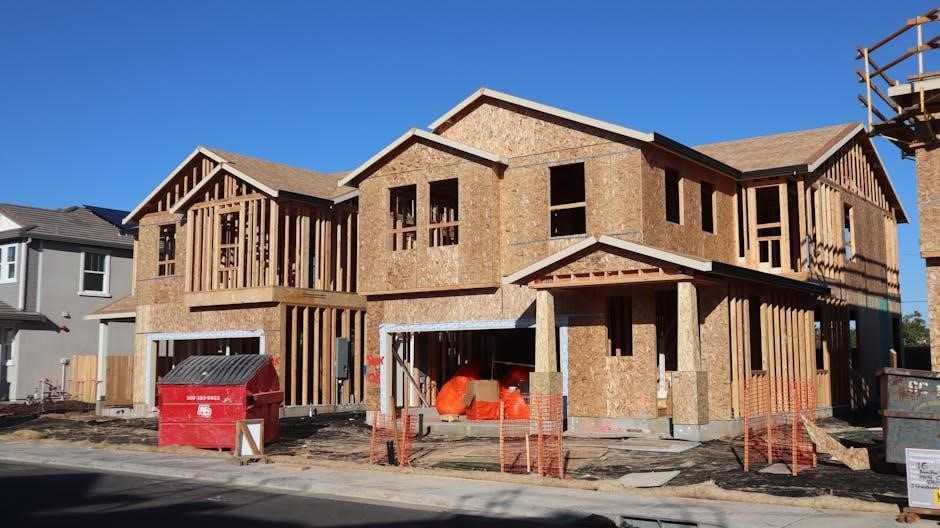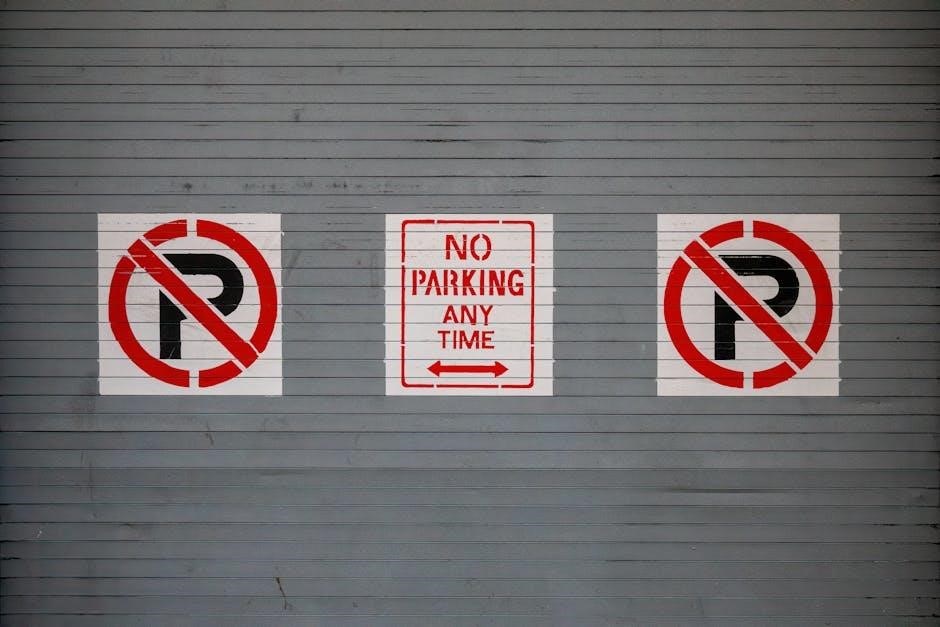The Notice of Intent to Lien in California is a crucial document protecting payment rights in construction projects, outlining the process for securing unpaid claims and ensuring compliance with state lien laws.
1.1 Overview of the Notice of Intent to Lien
The Notice of Intent to Lien is a preliminary document filed in California to notify property owners of potential lien claims due to unpaid debts. It outlines the intent to file a mechanics lien if payment issues remain unresolved. This notice is essential for contractors, subcontractors, and suppliers to protect their payment rights. The process involves drafting, serving, and recording the document, ensuring compliance with state laws. Digital tools like DocHub and pdfFiller facilitate easy editing, signing, and sharing of the PDF form, streamlining the process for all parties involved.
1.2 Importance of the Notice in Construction Projects
The Notice of Intent to Lien plays a vital role in California construction projects by ensuring transparency and fairness in payment disputes. It serves as a formal warning to property owners, enabling them to address unpaid claims before a lien is filed. This document protects contractors, subcontractors, and suppliers by preserving their lien rights and encouraging prompt payment resolution. Properly serving the notice also helps prevent project delays and legal complications, maintaining smooth workflow and stakeholder relationships throughout the construction process.

What is a Notice of Intent to Lien in California?
A Notice of Intent to Lien in California is a formal declaration asserting a party’s right to file a lien for unpaid construction-related claims.
2.1 Definition and Purpose of the Document
The Notice of Intent to Lien in California is a legal document notifying property owners of unpaid claims related to construction work. Its primary purpose is to establish a right to file a mechanics lien if payment disputes remain unresolved. This document is essential for contractors, subcontractors, and suppliers to secure payment for labor, materials, or services provided. By defining the scope of the claim and outlining the parties involved, it ensures transparency and accountability in construction projects, protecting both claimants and property owners while promoting fair resolution of payment issues.
2.2 Key Elements of the Notice
The Notice of Intent to Lien must include specific details to ensure its validity. Key elements are the property owner’s name, claimant’s information, description of the property, and a detailed breakdown of the unpaid amount. It should also outline the work performed, materials supplied, or services rendered. Additionally, the document must state the deadline for payment and the intent to file a lien if unpaid. These elements ensure clarity and enforceability, preventing disputes and providing a clear path for resolution.

2.3 Why is the Notice Required in California?
The Notice of Intent to Lien is required in California to provide property owners with formal notice of unpaid claims. This ensures transparency and fairness in construction transactions. It also protects contractors and subcontractors by preserving their right to file a mechanics lien if payment disputes remain unresolved. The notice serves as a final warning before escalating to legal action, promoting prompt resolution of payment issues. Compliance with this requirement is essential to maintain legal standing in lien-related disputes.

Legal Requirements for Filing a Notice of Intent to Lien
Filing a Notice of Intent to Lien in California requires adherence to state laws, including specific content and formatting guidelines to ensure legal validity and enforceability.

3.1 California Laws Governing Mechanics Liens
California laws governing mechanics liens are outlined in the California Civil Code, specifically sections 8000-9566. These laws establish the procedures, requirements, and protections for contractors, subcontractors, and suppliers to file a Notice of Intent to Lien. The laws ensure that parties providing labor or materials to a construction project are entitled to payment and can enforce their rights through a mechanics lien. Compliance with these statutes is essential to maintain the validity and enforceability of the lien. Failure to adhere to the legal framework can result in penalties or dismissal of the lien claim.
3.2 Necessary Information to Include in the Notice
The Notice of Intent to Lien must include specific details to ensure its validity. These include the claimant’s name, address, and contact information, as well as a detailed description of the work performed or materials supplied. The property owner’s name, property address, and a legal description of the property are also required. Additionally, the notice should state the amount owed, a description of the dispute, and a clear statement of intent to file a lien if payment is not received within a specified timeframe, typically 10 days. Including this information ensures compliance with California lien laws and protects the claimant’s rights.
3.3 Formatting Requirements for the Document
The Notice of Intent to Lien in California must adhere to specific formatting guidelines. The document should be typed in a clear, legible font, such as Arial or Times New Roman, size 12-point or larger. Proper margins and spacing are required to ensure readability. The notice must be printed on standard 8.5×11-inch paper and saved as a PDF to prevent alterations. It should include a header with the document title and a footer with page numbers. A declaration statement at the end, signed and notarized, is also mandatory. Compliance with these formatting rules ensures legal validity and professional presentation.
Steps to Prepare a Notice of Intent to Lien
Prepare by gathering project details, calculating lien amounts, identifying all parties involved, and ensuring compliance with California state laws and formatting requirements for accuracy.
4.1 Drafting the Notice: Essential Details to Include
Drafting a Notice of Intent to Lien requires including the project address, description of work, unpaid amount, and dates services were provided. Key details include the contractor’s or subcontractor’s name, the property owner’s name, and a clear statement of intent to file a lien. The document must also outline the reason for the lien, such as non-payment for labor or materials. Formatting should follow California’s legal standards, ensuring clarity and compliance. A warning about potential lien filing consequences should be included to notify the recipient of the seriousness of the matter.
4.2 Identifying the Parties Involved
Accurately identifying all parties involved is crucial when drafting a Notice of Intent to Lien. This includes the claimant (contractor or subcontractor), the property owner, and any other relevant parties like general contractors or lenders. The claimant must provide their full name, business address, and license number. The property owner’s name and address should also be clearly stated. Additionally, the hire party (who contracted the claimant) must be identified to establish the chain of responsibility. This ensures the notice is legally binding and enforceable under California law.
4.3 Deadlines for Serving the Notice
In California, the Notice of Intent to Lien must be served within specific deadlines to maintain its validity. The notice must be served at least 20 days before recording the lien. Additionally, it should be served within 30 days after the completion of work or services or 30 days after the last furnishing of materials. Missing these deadlines can result in the loss of lien rights. Contractors must prioritize timely delivery to ensure compliance and protect their ability to file a mechanics lien. Proper tracking of deadlines is essential to avoid legal complications.

Serving the Notice of Intent to Lien
Serving the Notice of Intent to Lien involves delivering the document to property owners and contractors, ensuring proper notification and adherence to legal requirements.
5.1 Methods of Serving the Notice
The Notice of Intent to Lien must be personally delivered or sent via certified mail with return receipt to ensure proof of delivery. First-class mail is also acceptable but less common due to lack of confirmation. Personal delivery involves handing the document directly to the property owner or contractor. Certified mail requires a signature upon receipt, providing legal proof of service. Proper service ensures the notice is enforceable and adheres to California’s legal standards for lien filing. Each method has specific requirements to validate the process.
5.2 Proof of Service Requirements
Proof of service is mandatory to confirm that the Notice of Intent to Lien was properly delivered. A signed acknowledgment or certified mail receipt serves as valid proof. Personal delivery must be witnessed and documented. For mailed notices, the return receipt acts as evidence. The proof must be filed with the county recorder where the property is located. Failure to provide proper proof can invalidate the lien process. Accurate records ensure compliance with California’s legal requirements for enforcing payment rights.

5.3 Consequences of Improper Service
Improper service of the Notice of Intent to Lien can have severe consequences. If the notice is not delivered correctly, the lien may be deemed invalid, and the claimant may lose their right to file a mechanics lien. This could result in the dismissal of the case or the inability to recover unpaid amounts. Additionally, improper service may delay the process, requiring the claimant to restart the procedure, incurring additional costs and time. Proper service is critical to ensuring enforceability.

Recording the Notice of Intent to Lien
Recording the Notice of Intent to Lien is a critical step in California. It involves submitting the document to the county recorder’s office where the property is located. Proper recording ensures the lien is officially recognized, protecting the claimant’s rights and notifying all parties involved. This step is essential for enforcing payment claims.
6.1 Where to Record the Notice in California
In California, the Notice of Intent to Lien must be recorded with the county recorder’s office in the county where the property is located. This ensures the lien is properly documented and recognized within the correct jurisdiction. Recording in the right county is essential for enforcing payment rights, as each county maintains its own records. Failure to record in the appropriate location can invalidate the lien, making it unenforceable. Always verify the property’s location to determine the correct county recorder’s office for filing. This step is crucial for ensuring the lien’s validity and enforceability.
6.2 How to Record the Notice with the County Recorder
To record the Notice of Intent to Lien, submit the completed document to the county recorder’s office where the property is located. Ensure the notice is properly filled out and includes all required information, such as the property description and parties involved. Attach any necessary supporting documents, like proof of service. Submit the notice in person, by mail, or through an online portal, if available. Pay the applicable recording fees, which vary by county. Once processed, the recorder will stamp and return a copy for your records. This step is essential for ensuring the lien is legally recognized.
6.3 Fees Associated with Recording
Recording fees for a Notice of Intent to Lien in California vary by county. Typically, the cost ranges between $20 to $50 per document, depending on the county recorder’s fees. Additional charges may apply for extra pages, oversized documents, or expedited services. Some counties also charge for certified copies or electronic filing; It’s essential to verify the current fees with the specific county recorder’s office before submitting the notice. These fees are separate from any legal or preparation costs associated with the document.
Impact of the Notice on Contractors and Property Owners
The Notice of Intent to Lien protects contractors by ensuring payment security and alerts property owners of potential liens, preventing project delays and financial disputes.

7.1 Protecting Contractors’ Rights
The Notice of Intent to Lien is a critical tool for protecting contractors’ rights in California. It ensures that contractors who provide labor or materials have a legal pathway to secure payment. By filing this notice, contractors formalize their intent to pursue a mechanics lien if unpaid, safeguarding their ability to recover funds. This process prevents unfair treatment and ensures contractors are not left without recourse for unpaid work. Proper documentation and adherence to deadlines are essential to maintain these rights.
7.2 Implications for Property Owners
The Notice of Intent to Lien places property owners on formal notice that a lien may be filed if unpaid debts remain unresolved. This can impact the property’s marketability and value, as it creates a cloud on the title. Property owners may face challenges selling or refinancing the property until the lien is resolved. It is crucial for owners to address payment disputes promptly to avoid further complications. Ignoring the notice can lead to a mechanics lien filing, which could result in foreclosure proceedings. Timely resolution is essential to protect the property’s value.
7.3 Potential Disputes and Resolutions
A Notice of Intent to Lien can lead to disputes between contractors and property owners, often regarding payment amounts, work quality, or lien validity. Property owners may contest the lien if they believe it was filed unjustly. Resolving these disputes may involve negotiations, mediation, or legal action. Prompt communication and documentation are key to addressing issues before they escalate. Legal counsel can assist in navigating these conflicts to ensure fair resolutions and prevent prolonged delays or financial losses for all parties involved.
Best Practices for Using the Notice of Intent to Lien
Always adhere to California state laws, ensure timely filing, and maintain clear communication with all parties involved to avoid delays or disputes.
8.1 Timing: When to Send the Notice
In California, the Notice of Intent to Lien must be served at least 10 days before recording a mechanics lien. Timing is critical to ensure compliance with state laws. Contractors, subcontractors, and suppliers must act promptly to preserve their rights. Missing the deadline can result in the loss of lien rights. Always verify the specific timeframe required under California’s Civil Code. Proper timing ensures the notice is effective and legally binding, protecting your interests in construction projects. Consulting a legal professional can help avoid errors and delays in the process.
8.2 Ensuring Compliance with State Laws
To ensure compliance with California state laws when sending a Notice of Intent to Lien, it’s crucial to include all required information, such as the amount owed, a detailed description of the work performed, property details, and the names of all parties involved. Adhering to the correct format and structure as outlined in the California Civil Code is essential. Deadlines must be strictly followed, and the notice must be served through approved methods like certified mail or in-person delivery. Staying informed about any legal changes and using official state forms can help avoid errors and ensure the notice is valid. Compliance prevents potential issues in court and ensures lien rights are maintained.
8.3 Maintaining Records of the Notice
Keeping accurate and organized records of the Notice of Intent to Lien is essential for compliance and legal protection. This includes retaining copies of the notice, proof of service, and any related correspondence. Proper documentation ensures that all parties can verify the legitimacy of the notice and its timely delivery. Maintaining these records for at least five years is recommended, as they may be needed for audits, disputes, or future legal actions. Organized files also help prevent misunderstandings and demonstrate adherence to California’s legal requirements.
Common Mistakes to Avoid When Filing a Notice of Intent to Lien
Missing deadlines for filing the notice can invalidate lien claims.
Incorrect or incomplete information may lead to disputes or dismissal.
9.1 Errors in Filling Out the Form
Common mistakes include misspelling names, incorrect property descriptions, and wrong dates. Ensure the form reflects the correct start date of work and last furnishing of services. Verify payment amounts and itemize charges accurately. Avoid omitting required signatures or dates, as these errors can delay or invalidate the lien process. Double-check all information before submission to prevent disputes or dismissal of the claim. Attention to detail is crucial to maintaining the validity of the notice and ensuring compliance with California state laws.
9.2 Missing Deadlines for Filing
Failing to meet deadlines can result in the loss of lien rights. In California, the Notice of Intent to Lien must be served and recorded within specific timeframes, typically 20 days before filing a mechanics lien. Missing these deadlines can invalidate the claim, leaving contractors unpaid. It is crucial to track and adhere to statutory timelines to ensure the lien process proceeds without delays or dismissals. Proper calendar management and legal guidance can help prevent such costly oversights and protect payment rights.
9.3 Failure to Properly Serve the Notice
Improper service of the Notice of Intent to Lien can invalidate the entire process. In California, the notice must be served via certified mail, return receipt requested, or personal delivery to the property owner or prime contractor. Failure to follow these methods or neglecting to provide proof of service can result in the lien being dismissed. Contractors must ensure proper service to maintain their rights and avoid costly disputes. Always verify service methods and retain documentation to prevent potential issues.

Resources for Downloading and Filling the Notice of Intent to Lien PDF
Access California’s Notice of Intent to Lien PDF from official state websites or legal platforms. Use tools like Adobe Acrobat for editing and DocuSign for e-signing. Consult legal professionals for assistance.
10.1 Reliable Websites for Downloading the Form
The Notice of Intent to Lien PDF can be downloaded from California’s official government websites, such as the California Secretary of State or Department of Consumer Affairs. Additionally, reputable legal platforms like LawDepot, Rocket Lawyer, or Nolo provide accurate templates. Ensure the form is specific to California and complies with state laws. Always verify the source’s credibility to avoid unauthorized or outdated versions.
10.2 Tools for Editing and Signing the PDF
Several tools can help you edit and sign the Notice of Intent to Lien PDF. Adobe Acrobat is ideal for editing text and annotations. Online platforms like DocuSign and SignNow allow electronic signatures and document management. Smallpdf offers editing and conversion features, while PDF-XChange Editor provides free basic editing. Google Docs and Canva can also import PDFs for limited adjustments. Ensure the tools support California-specific requirements and maintain document integrity for legal purposes.
10.3 Legal Assistance for Completing the Notice
Seeking legal assistance is crucial for accurately completing the Notice of Intent to Lien in California. Construction law can be complex, and attorneys specializing in real estate or construction law can provide guidance. They ensure compliance with California’s lien laws, review the document for accuracy, and help avoid legal pitfalls. Legal professionals can also assist in resolving disputes or addressing issues with property owners. Their expertise ensures the notice is enforceable and protects your rights. Consulting a lawyer is a wise investment to prevent costly errors and delays.
